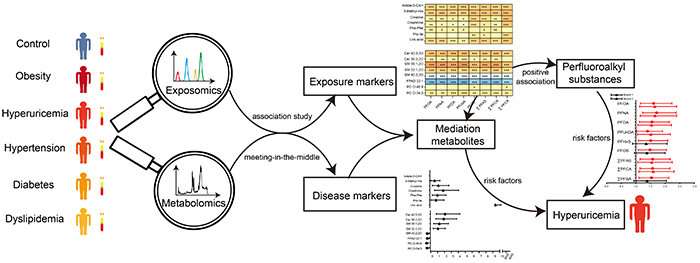Risk of chronic diseases caused by exogenous chemical residues

Chronic diseases are main killers affecting the health of human. The morbidities of major chronic diseases such as obesity, hypertension, diabetes, hyperuricemia and dyslipidemia are as high as 10% to 30%, showing a gradually upward trend as well.
More and more studies have shown that environmental pollution is a major health risk factor that cannot be ignored. However, the evidence for their relationship is equivocal and the underlying mechanisms is unclear.
Recently, a research group led by Prof. Xu Guowang from the Dalian Institute of Chemical Physics (DICP) of the Chinese Academy of Sciences (CAS) discovered the risk of chronic diseases caused by exogenous chemical residues through metabolome-wide association study.
Their findings were published in Environment International on Oct. 8. Researchers from National Institute for Nutrition and Health of the Chinese Center for Disease Control and Prevention, and Tongji Medical College of Huazhong University of Science and Technology were also involved in this study.
The researchers discovered positive associations of serum perfluoroalkyl substances (PFASs) with hyperuricemia, and revealed the mechanism of the relationship between the exogenous chemical residues in the serum and the risk of chronic diseases at the metabolic level.
The researchers investigated the relationship between 106 exogenous chemical residues and five chronic diseases in 496 serum samples. They revealed the metabolic perturbations related to exogenous chemical residues and chronic diseases by the metabolome-wide association study combined with meeting-in-the-middle approach and mediation analysis, and investigated the further potential underlying mechanism at the metabolic level.
"PFASs were the risk factor for hyperuricemia," said Prof. Xu. Lipid species including glycerophospholipids and glycerides presented the strongest correlation with exposure and disease, which were not only positively related to PFASs exposure but also the risk factor for hyperuricemia. "We also found that key mediation metabolites mediated 25% to 68% of the exposure-disease risk relationship," Prof. Xu added.
This study provides in-depth etiological understanding for the occurrence and development of diseases, which may be helpful for the early detection of the disease and the identification of early warning markers.
More information: Lei You et al, Metabolome-wide association study of serum exogenous chemical residues in a cohort with 5 major chronic diseases, Environment International (2021). DOI: 10.1016/j.envint.2021.106919


















